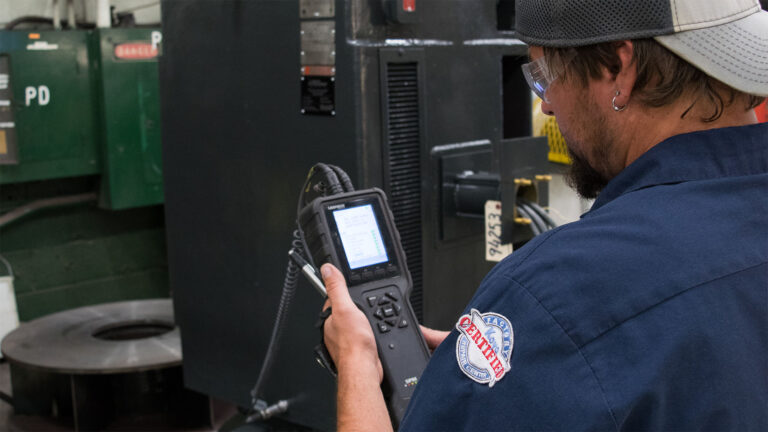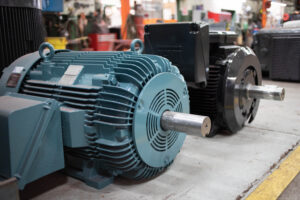
A motor that “runs too hot” could be the symptom of an endless list of issues. So how do you know what the root cause of your motor’s temperature spike is? Throughout this article we will address some of the most common reasons your motor could be overheating; as well as how to verify that overheating is really causing your problems, how to correct overheating, and what could happen if you leave this over temperature problem unchecked.
What Causes Overheating?
Your motor could be overheating for many different reasons. The most common reasons are:
- Electrical Overload
- This usually happens when your motor is too small for your application, but sometimes a belt that is too tight can simulate an electrical overload. To verify that overheating is caused by electrical overload and not a tight belt, you should measure amp draw using an ammeter. If the draw is 110% or more of what your motor is rated for (you can find this rating on the motor nameplate) the motor is overloaded.
- Low Resistance
- This is the most common reason for an overheating motor. Low resistance is caused by degradation of the motor windings from overheating, corrosion, or physical damage.
- It’s Dirty
- Dust and debris could have gotten inside or built up around the outside of your motor. This can cause filters to become clogged. You could also see an accumulation of debris in the outside cooling fins; rendering your motor unable to cool itself normally.
- You’re Stopping and Starting Your Motor too Often
- It is not uncommon for your motor to draw about 5x more current at initial startup than while it is running as normal, causing a short electrical overload which can cause short term overheating. Constantly starting and stopping your motor doesn’t give it a chance to cool completely, so the heat is compounding each time you start the motor again.
- Ambient Temp is too High for Insulation Class
- If your motor is forced to operate in a high temp environment or at a higher elevation than it is rated for, you could be exceeding the temperature for your motors insulation class causing your insulation to degrade quickly.
- Vibration
- Vibration can cause overheating by causing damage to insulation. This causes lead wires to become brittle and not carry current as efficiently. Vibration also speeds up bearing failure by causing both the ball bearings and the housing to become pounded out of shape over time.
- Environmental Factors
- Environmental factors such as chemical abrasives in the air, high humidity, high temperature and high altitude operation can all cause overheating in your motor.
- Oil Leaks
- Oil leaks, if left unchecked, can lead to oil coating the windings of your motor and attracting dirt or other particles; effectively insulating the coils and causing it to overheat.
- Worn Bearings
- Worn bearings can cause rotor rub, a motor bark or growl on startup, or front to back/side to side play. These issues, if they have gone on for an extended period of time, usually mean you need to replace the whole motor.
- Belts are too Tight
- Tight belts can simulate an electrical overload and cause bearing wear as described above. Be sure to only tighten your belts to the manufacturers recommended parameters.
How to Verify Overheating?
There are a few ways to verify that the trouble you are having is caused by overheating. You can install a thermostat or temperature sensors directly onto your motor to give you an accurate temperature reading that is always easily accessible. Another method is using an infrared camera to identify hot spots throughout your motor. This has become more popular in recent years due to IR cameras becoming much more affordable and accessible.
Technicians used to say that if you couldn’t leave your hand on the motor for 3 seconds it was running too hot, but that is no longer best practice. Due to improvements in motor housings, you may not be able to tell from touch alone when your motor is too hot. Surface temperature could be anywhere from 15-60o C below the hot spot temperature reading depending on the type of motor enclosure you have.
What Can Happen if I Don’t Correct Overheating?
If overheating is not corrected, insulation throughout your motor can degrade rapidly. For every 10o C increase in temperature over your motors maximum rated insulation temp, you cut your insulation life in half. Inversely, for every 10o C your run your motor under its max temp you increase your insulation life by 2x. (Unfortunately, this doesn’t mean your insulation will last forever. It is still susceptible to moisture, chemicals, vibration, and abrasives carried through the air that will shorten its lifespan.)
How Can I Prevent Overheating?
- To prevent your motor from overheating you must be sure to keep it clean. By cleaning your motor every time you perform periodic maintenance, you will be preforming a small action that can have large positive consequences.
- Install sensors on your motor that monitor temperature so you have an idea of the trends for your specific motor.
- Reduce your current draw to under your motors operating capacity.
- Limit how often you start and stop your motor. Give it time to cool completely before starting it up again.
- Make sure your motor and load are properly matched. Never undersize your motor, oversize if you are worried about load matching.
- Test motor temperature as part of routine maintenance.
- Don’t ignore small problems like vibration; they will lead to much larger, more expensive problems.
- Use the correct insulation class for your application.
- Keep your motor in a clean, cool area. Think about installing an air filtration system in the same room as your motor to filter out debris that could become lodged inside or around your motor.
This article is based off our EMC Webinar: Getting the Most out of Your Electric Motor
Got More Motor Questions? We Can Help!
Call 800-595-5315 Or Connect With Our Expert Technicians Here:
Other Articles
- How to Reduce Motor Downtime and Keep Your Motor Happy
- Critical Spare Planning
- The Three Most Common Externally Caused Motor Failures

Gary has 30+ years of experience at Energy Management Corporation working in all aspects of motor and mechanical repairs. In his extensive career, some of the interesting projects he has worked on include Hoover Dam hydro generators, Utah power sub stations, harmonic filters for VFDs, and motor for the Buckeye Bullet that set the land speed record for electric car.





